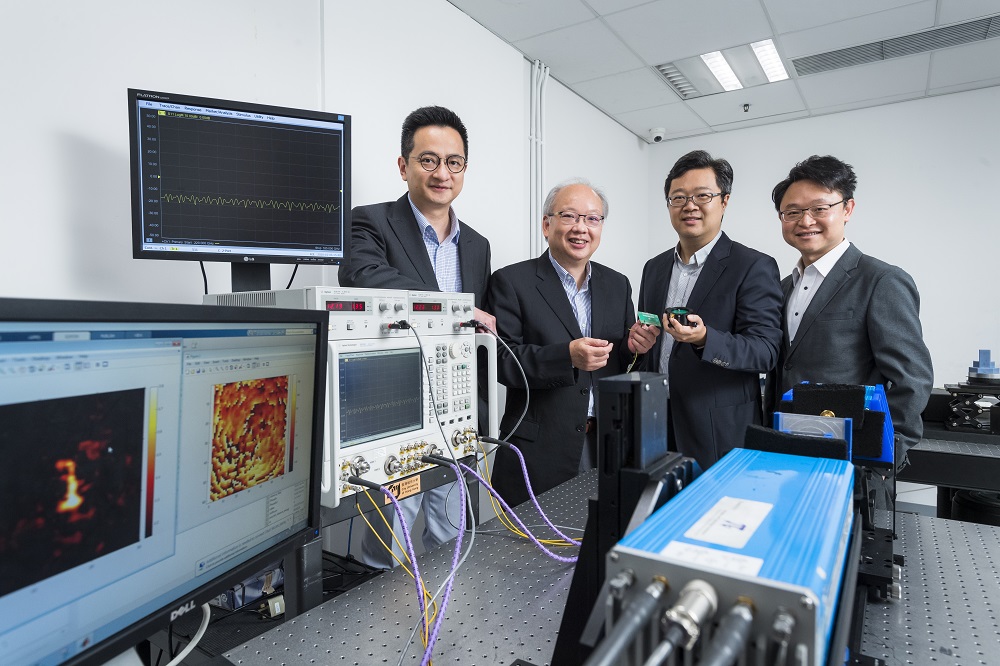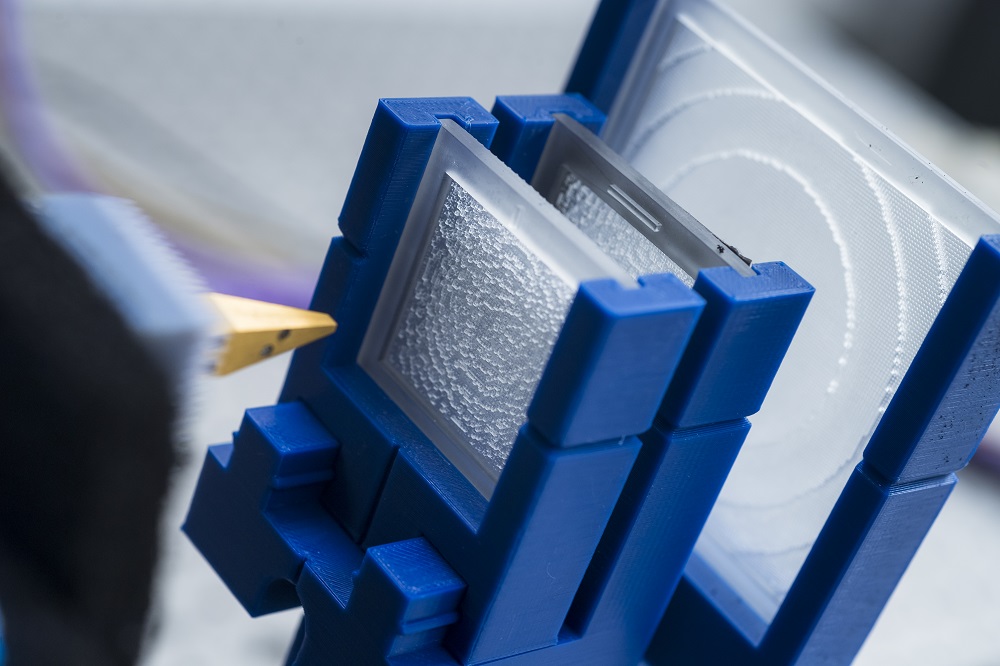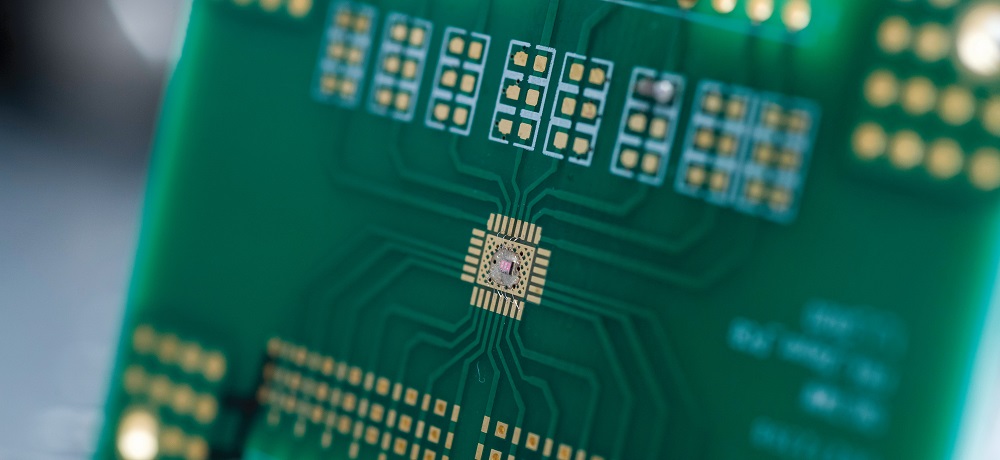Building a Compact System for Terahertz Technology and 6G Communications
With the arrival of fifth-generation (5G) wireless technology, which is set to provide massive, ultra-high speed connectivity in the next five to 10 years, the development of sixth-generation (6G) technology is already on its way. A team of multi-disciplinary experts, led by Professor Chan Chi-hou, Chair Professor in the Department of Electrical Engineering (EE) and Director of the State Key Laboratory of Terahertz and Millimeter Waves (SKLTMW) at CityU, has been working on advancing the development of terahertz (THz) technology for 6G communications, imaging and spectroscopy.
THz waves exist in the electromagnetic spectrum between the conventional microwave and infrared regions. This is a broad frequency band with a wide range of applications. For example, THz technologies have been used to detect melamine in milk powder, antibiotics in food matrices, pesticides in vegetables, and foreign objects in drugs.
Developing highly-efficient THz sources
“However, the widespread application of THz technologies is hindered by bulky and expensive THz sources,” said Professor Chan, who is leading a team of electronic engineers, materials scientists, biologists and chemists to work on the Theme-based Research Scheme project, whose aim is to develop high-power THz sources using integrated circuits and optoelectronic approaches, and exploring different applications of THz technology.
Professor Chan explained that THz radiation sources are usually generated in two ways: i) using integrated circuits (ICs) to generate up-conversion from the lower microwave frequency to THz radiation, and then transmit it via antennas; or ii) using the optoelectronic approach, which involves using materials science to generate down-conversion from the higher optical frequency. But both approaches face the same problem: the output power of the THz source is relatively low.
To enhance the radiation efficiency for both approaches, Dr Steve Wong Hang, Associate Professor in the EE Department, is developing high-performance antennas in the terahertz spectrum, while Professor Johnny Ho Chung-yin, in the Department of Materials Science and Engineering, is working with his team to synthesise high-quality nanowires to generate THz sources through down-conversion. “These nanowires have properties that are not found in the bulk size and exhibit good performance in enhancing the efficiency of converting visible light to THz,” said Professor Ho. He is also synthesising high-quality monolayer graphene to explore its potential in generating THz radiation.

Active antennas for 6G communications
“With compact, low-cost THz sources available, we can apply them in different ways,” said Professor Chan. “For instance, the antennas we developed can be used to generate THz and for 6G wireless communications.”

Earlier, the International Telecommunication Union announced the frequency range for future 6G wireless communications, which exactly matches Dr Wong’s research focus – developing antennas for a frequency range of 0.2 to 0.5 THz. After years of fundamental research by Dr Wong and the SKLTMW team, they are now developing a new technology of programmable antennas using functional materials, which can enable beam-forming techniques.
“With functional materials, we can manipulate the properties of the generated waves, and control the beam formation and beam direction of THz waves. This means the direction of the beams emitted can be changed according to need. To put it simply, an active antenna system on a mobile device enables beam-searching and beam-forming technology, eliminating poor connection problems,” explained Dr Wong. “This can greatly enhance communications quality and will be of great demand in the age of high-speed, high-volume 6G wireless communications.”
Spectroscopy and imaging for cancer drug development
The team is also exploring THz applications in spectroscopy and imaging for addressing health-related issues. “Many studies have shown that the absorption of THz radiation by cancer and normal tissues is different. So we are interested in finding out how we can apply THz in cancer studies,” said Professor Kenneth Lo Kam-wing, in the Department of Chemistry, who is also one of the members of the multi-disciplinary team.
In particular, he is investigating whether THz imaging can reveal the cancerous parts of tissues more precisely and the changes of the tumour cells for drug testing; and whether THz can be used as a spectroscopic tool for tracing compounds inside tissues for cancer drug development, as a supplemental approach to fluorescent biological probes to stain tissues.
“We hope our project will improve the performance of the THz system and generate more new research ideas by integrating the input from experts from different disciplines, thus achieving wider benefits for society,” said Professor Chan.

Integrating an antenna measurement system on their own
Performance characterisations of antennas for different application scenarios are essential for exploiting the benefits of the THz frequency band. However, the SKLTMW team has found that there are no antenna measurement facilities for higher millimetre and THz wave bands that meet their needs available in the market. “Therefore, we are trying to build a high-resolution antenna measurement system for millimetre and THz research on our own with bought components to support research and development activities in both academia and industry,” said Dr Wong, who is the Project Coordinator of an equipment grant project supported by the Collaborative Research Fund (CRF).
In collaboration with a team from the University of Hong Kong, they will build a world-class antenna measurement facility that can conduct near-field and far-field radiation measurements through the help of robotic arms. “We hope the new facility will drive high-frequency electronic development to a new level of excellence and promote more collaboration with other institutes in southern China, with CityU playing a leading role, contributing to Hong Kong’s role as an international hub for innovation,” said Dr Wong.
This research article originated from CityU RESEARCH.
